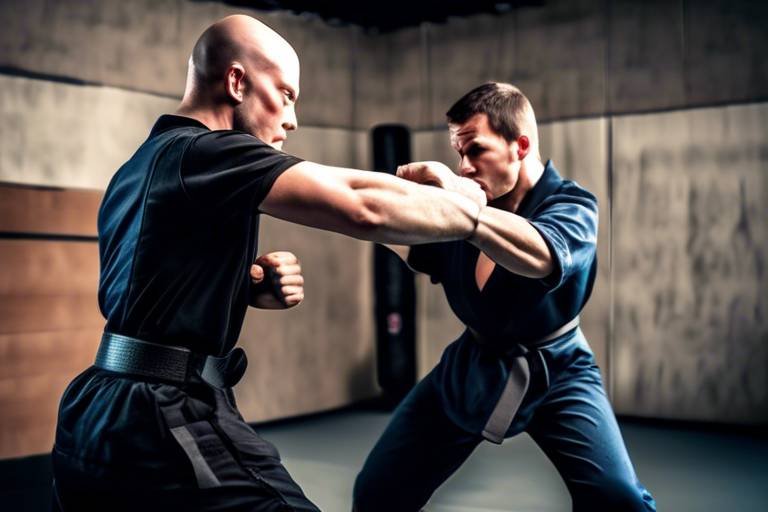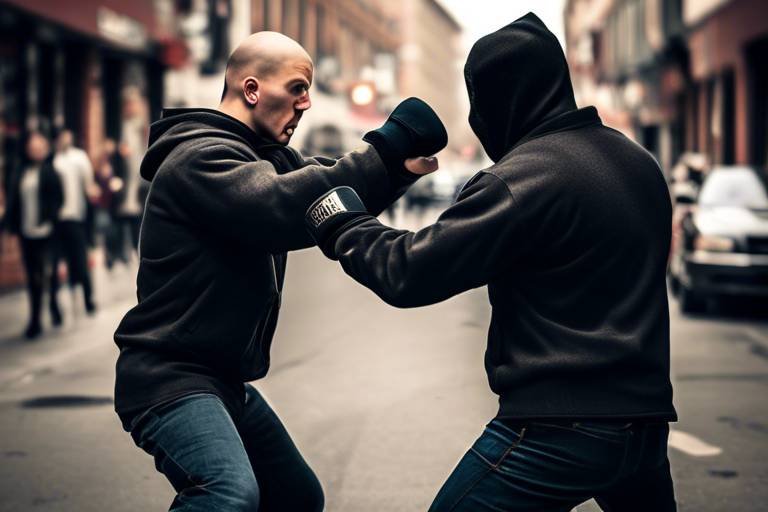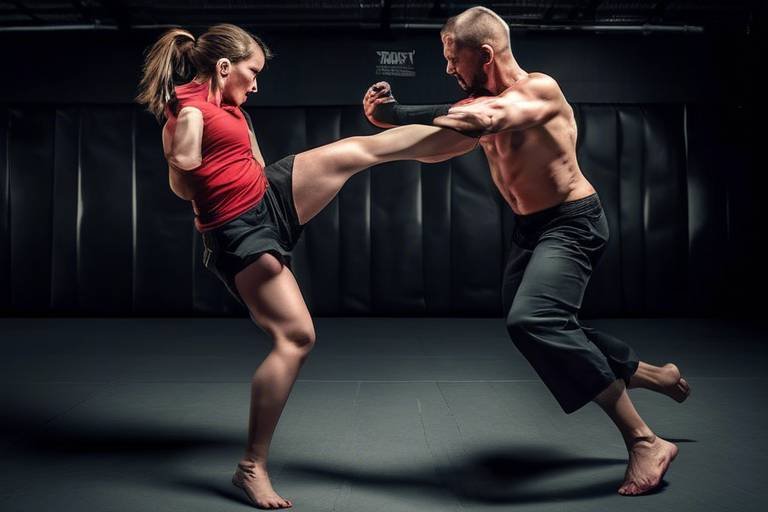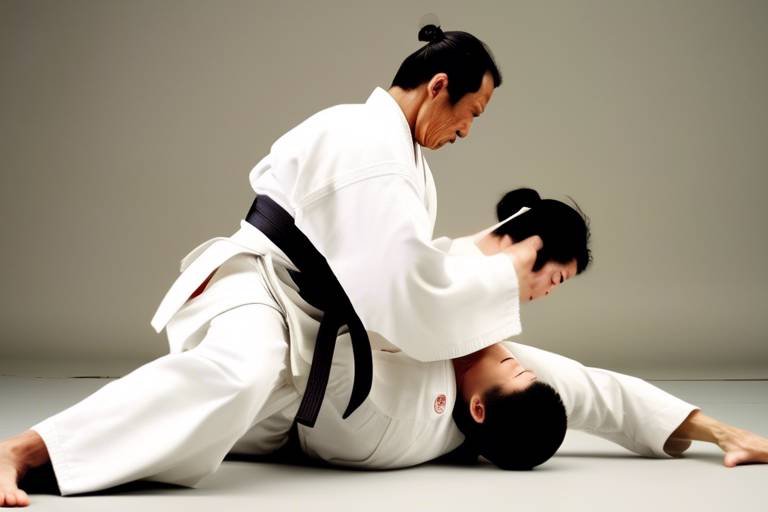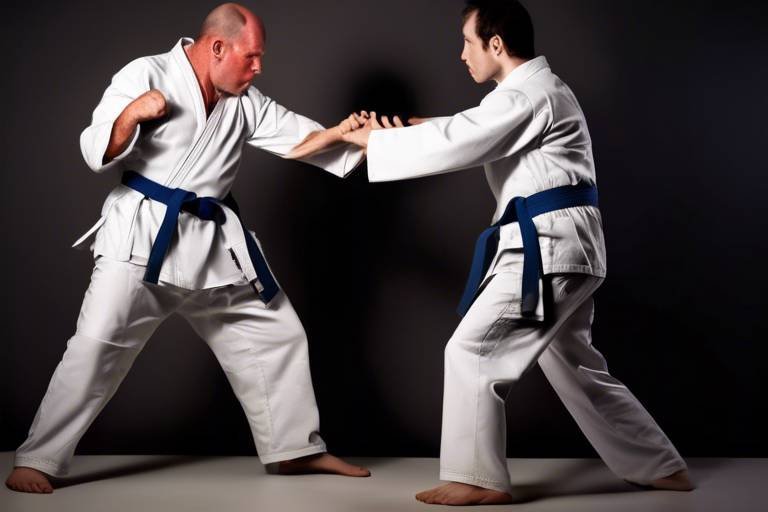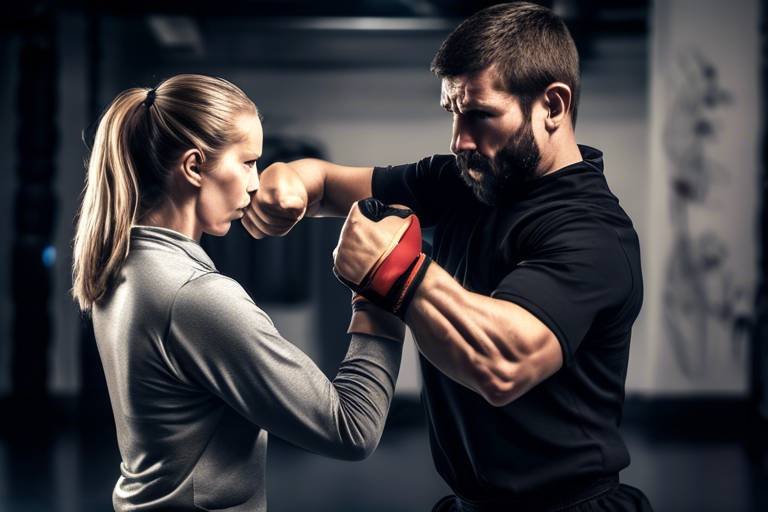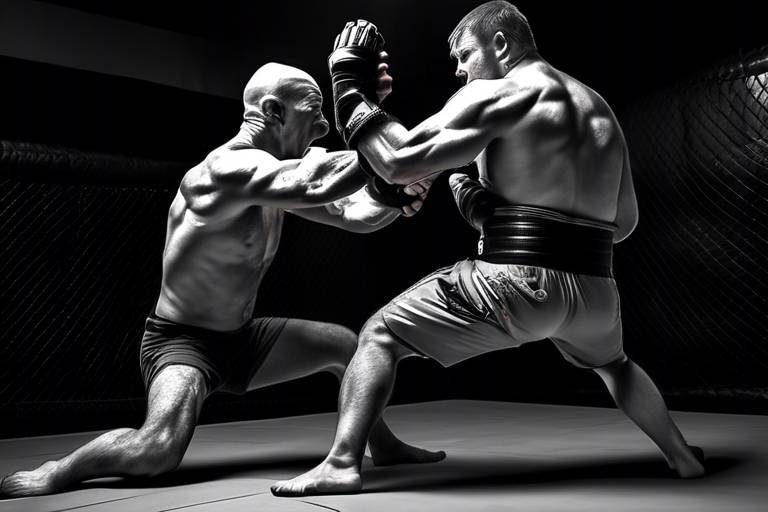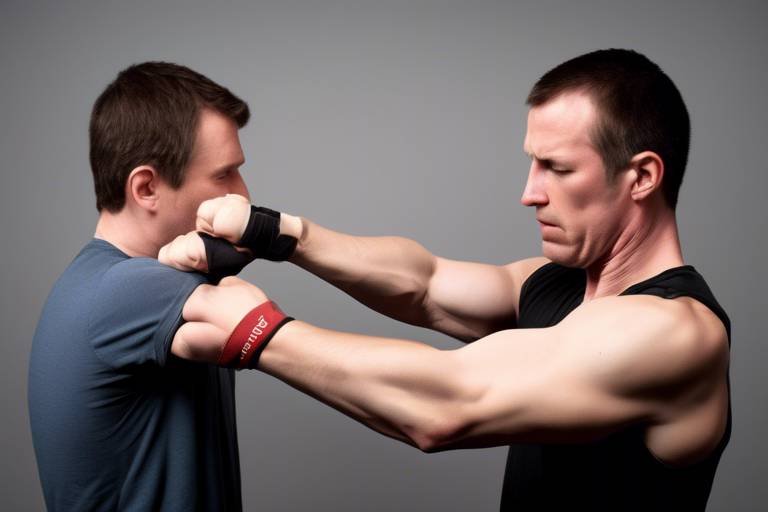The Role of Muscle Memory in Self-Defense Training
Self-defense is not just about knowing techniques; it's about being able to execute them when it matters most. This is where muscle memory comes into play. Muscle memory is the phenomenon that allows our brains and bodies to work in harmony to perform actions automatically, without conscious thought. Imagine being in a high-pressure situation where your heart is racing, and your instincts kick in. Wouldn't it be comforting to know that your body could react swiftly, executing self-defense moves you've practiced countless times? That's the power of muscle memory!
In the realm of self-defense training, muscle memory enhances not only the effectiveness of techniques but also improves reaction times and builds confidence. When faced with a potential threat, the last thing you want is to hesitate or second-guess your movements. Instead, you want your body to respond instinctively, allowing you to focus on the situation at hand rather than thinking about the next move. This article will delve into the science behind muscle memory, the importance of repetition, mental aspects, and practical strategies to enhance your self-defense training.
Muscle memory is a fascinating interplay between the brain and the nervous system. When you practice a movement repeatedly, your brain creates neural pathways that streamline the communication between your mind and muscles. This means that the more you practice, the more efficient your body becomes at executing those movements. Think of it as a well-worn path in a forest; the more people walk it, the clearer and easier it becomes to navigate. In self-defense, this translates to quicker, more effective responses when you need them the most.
Repetition is the cornerstone of muscle memory. When you consistently practice self-defense techniques, your body begins to recognize these movements as second nature. This is crucial because, in a real-life scenario, you won't have the luxury of time to think through your actions. You want your responses to be automatic. The more you drill your techniques, the more your body learns to react without hesitation. Imagine trying to ride a bike for the first time; it takes practice to balance and steer. But eventually, it becomes second nature. The same principle applies to self-defense training.
But muscle memory isn't just physical; there's a significant mental component involved. Visualization and mental rehearsal can significantly enhance your physical performance. When you visualize yourself executing self-defense techniques successfully, you're essentially training your brain to respond effectively. This mental practice strengthens the neural pathways associated with those movements, making them even more accessible during high-pressure situations. So, whether you're in a dojo or at home, take a moment to close your eyes and visualize your moves. It can make a world of difference!
While muscle memory is a powerful tool, it's essential to understand how stress can impact your performance. High-stress environments can disrupt your ability to recall techniques, leading to slower reaction times. This is why training under pressure is vital. By simulating stressful scenarios during practice, you can condition your body and mind to perform effectively, even when the stakes are high. It's like training for a marathon; you don't just run on a flat track—you practice on hills and in varying weather conditions to prepare for race day.
To maximize the benefits of muscle memory in your self-defense training, consider incorporating the following strategies:
- Practice regularly: Set aside dedicated time for training to reinforce your skills.
- Focus on technique: Quality over quantity is essential; ensure you're performing techniques correctly.
- Use varied drills: Mix up your training routines to keep your body and mind engaged.
- Incorporate mental rehearsal: Visualize your techniques to strengthen your neural pathways.
Effective practice is key to developing muscle memory. Structure your training sessions to maximize retention and skill development. Start with a warm-up to get your muscles ready, followed by focused drills on specific techniques. Don't forget to cool down and reflect on what you've learned. Regularly assessing your progress will help you identify areas for improvement, ensuring you're always moving forward.
Drills are an essential part of reinforcing muscle memory. Incorporate specific drills into your self-defense training to enhance automatic responses and technique proficiency. For example, practice basic strikes, blocks, and escapes repeatedly until they become second nature. The more you drill, the more your body will remember how to react when it counts.
Sparring provides a dynamic environment for practicing muscle memory. It simulates real-life encounters, allowing you to apply your techniques in a controlled yet unpredictable setting. This not only helps you develop real-time reactions but also fosters adaptability—an essential trait in self-defense. Think of sparring as a dance; you learn to move fluidly with your partner, responding to their movements while executing your own techniques.
Lastly, regularly reviewing your progress is vital for muscle memory development. Seek feedback from instructors or training partners to identify strengths and weaknesses. Adjust your training accordingly to ensure continuous improvement and skill retention. Remember, the journey of self-defense training is ongoing, and every step forward counts!
- What is muscle memory? Muscle memory refers to the process where the brain and nervous system work together to improve motor skills, allowing for automatic responses during physical activities.
- How can I improve my muscle memory for self-defense? Consistent practice, mental rehearsal, and incorporating varied drills into your training can enhance muscle memory.
- Does stress affect muscle memory? Yes, stress can impact performance and reaction times. Training under pressure can help build resilience.

The Science Behind Muscle Memory
Muscle memory is a fascinating phenomenon that goes beyond the simple idea of our muscles "remembering" movements. At its core, muscle memory is a complex interplay between the brain and the nervous system, allowing us to perform physical tasks with remarkable efficiency and speed. When you practice a self-defense technique repeatedly, your brain forms neural pathways that enable quicker and more coordinated muscle responses. This means that when the time comes to defend yourself, your body can react almost instinctively, as if on autopilot.
So, how does this process work? Initially, when you learn a new skill, such as a specific self-defense maneuver, your brain is highly active in processing the movements. This involves several regions of the brain, including the motor cortex, which is responsible for planning and executing movements, and the cerebellum, which helps coordinate those movements. As you practice, the connections between these neurons strengthen, making it easier for your body to execute the same movements in the future without conscious thought.
To visualize this, think of your brain as a busy highway. When you first learn a self-defense technique, you’re paving a new road. Initially, it might be bumpy and slow, but with every practice session, that road becomes smoother and more efficient. Eventually, you can navigate it with ease, even under pressure. This is why repetition is so crucial; it reinforces these pathways, creating a kind of "muscle memory" that allows for rapid responses.
Moreover, muscle memory is not solely about physical repetition; it also involves cognitive processes. Your brain is constantly storing information about the movements, and when under stress, it relies on this stored information to trigger the appropriate responses. For instance, when faced with a potential threat, the brain quickly retrieves the necessary techniques from memory, allowing you to react swiftly. This is why understanding the science behind muscle memory can significantly enhance your self-defense training.
In summary, muscle memory is a remarkable blend of neurological and physical processes that allows individuals to perform complex movements with ease. By understanding how our brain and body work together, we can better appreciate the importance of consistent practice in self-defense training. The more we train, the more our bodies adapt, leading to faster, more instinctive reactions when it matters most.
- What is muscle memory? Muscle memory refers to the brain’s ability to remember and execute physical movements through repeated practice.
- How long does it take to develop muscle memory? The time it takes to develop muscle memory can vary based on the complexity of the skill and the frequency of practice, but consistent training over weeks or months can lead to significant improvements.
- Can muscle memory be lost? Yes, if you stop practicing a skill for an extended period, the neural pathways can weaken, and you may need to re-train your body to perform the movements efficiently.
- How does stress affect muscle memory? High-stress situations can impact muscle memory by making it harder to recall movements. However, training under stress can help reinforce muscle memory and improve performance in real-life scenarios.

When it comes to mastering self-defense techniques, repetition is not just a suggestion; it's a necessity. Think of it like learning to ride a bike or play a musical instrument. The first few attempts might feel awkward, but with consistent practice, those clumsy movements transform into fluid, automatic actions. This process is crucial in self-defense, where every second counts. In high-pressure situations, your body needs to react instinctively, without the interference of conscious thought. That's where muscle memory comes into play, and repetition is the key to developing it.
Every time you practice a self-defense move, whether it's a punch, kick, or defensive maneuver, you're essentially wiring your brain and muscles to respond in a specific way. This is not just about physical training; it's about creating a mental blueprint for your body to follow. Over time, the more you repeat a technique, the more it becomes ingrained in your muscle memory. This means that when faced with a real-life threat, your body can execute the technique almost automatically, allowing you to focus on the situation rather than the mechanics of the move.
Consider this: in a self-defense scenario, you might only have a fraction of a second to react. If you've practiced a technique repeatedly, your response becomes a reflex rather than a thought process. This automaticity can be the difference between successfully defending yourself and being caught off guard. So, how can you make the most of repetition in your training? Here are a few strategies:
- Consistent Practice: Set aside time each week to practice specific techniques. Consistency is key in reinforcing muscle memory.
- Focus on Quality: While repetition is important, practicing with proper form and technique is crucial. Quality over quantity will yield better results.
- Vary Your Drills: Incorporate different drills that challenge your skills and keep your training sessions engaging. This prevents monotony and enhances learning.
As you integrate these practices into your training routine, you'll likely notice a significant improvement in your reaction times and overall confidence in your self-defense abilities. Remember, repetition is not just about doing the same thing over and over; it's about refining your skills and building a solid foundation for effective self-defense. Embrace the process, and soon enough, those techniques will feel second nature, ready to be unleashed when it matters most.

When we think about muscle memory, we often picture the physical aspect of training—repeating moves until they become second nature. However, the mental component is just as crucial in self-defense training. The brain plays a pivotal role in how we learn, retain, and execute these techniques under pressure. Have you ever noticed how a skilled martial artist seems to react almost instinctively during a confrontation? That’s not just the body at work; it’s the mind, too!
Visualization is a powerful tool that can significantly enhance your muscle memory. By mentally rehearsing techniques, you create a mental blueprint that your body can follow when it counts. Imagine you’re preparing for a big game; athletes often visualize their plays to improve performance. Similarly, in self-defense, if you can picture yourself executing a move flawlessly in your mind, you’re more likely to perform it effectively in real life. Studies have shown that mental practice can activate the same neural pathways as physical practice, making it a vital part of your training regimen.
Moreover, the concept of mental rehearsal can’t be overlooked. This technique involves going through the motions of a self-defense move in your mind, which can help solidify the physical execution of that move. For instance, if you’re learning how to perform a specific escape technique, take a moment to close your eyes and visualize each step. Picture the scenario, feel the movements, and imagine the sensations you would experience. This practice not only reinforces your learning but also builds confidence—an essential trait when faced with a threatening situation.
In addition to visualization and mental rehearsal, it’s important to consider the role of focus and concentration in muscle memory development. When you train, your mind should be fully engaged in the task at hand. Distractions can lead to mistakes and hinder the retention of techniques. To cultivate better focus, try to eliminate external distractions during practice sessions. This could mean training in a quiet space or setting specific goals for each session. The more you can immerse yourself in the training, the more effective it will be.
Lastly, let’s not forget about the emotional aspect of muscle memory. Stress and anxiety can cloud our judgment and slow our reactions. By training your mind to remain calm under pressure, you can enhance your muscle memory. Techniques such as breathing exercises and mindfulness meditation can help you manage stress levels, allowing for clearer thinking and quicker reflexes during self-defense situations. Remember, your mind and body are partners in this journey, and nurturing both will lead to greater success in your self-defense training.

Stress is a double-edged sword, especially when it comes to self-defense training. On one hand, a certain level of stress can enhance performance by sharpening focus and increasing adrenaline levels. However, excessive stress can lead to detrimental effects on muscle memory and overall performance. When faced with a high-stress situation, such as a confrontation, the body enters a fight-or-flight response, which can hinder the ability to recall learned techniques. This is where understanding the impact of stress becomes crucial for anyone serious about self-defense.
During moments of intense stress, the brain may struggle to process information quickly. This can result in a phenomenon known as "stress-induced tunnel vision," where the mind focuses on a narrow range of stimuli, making it difficult to remember complex techniques or strategies. As a result, practitioners might revert to instinctual responses rather than the refined skills they practiced. This highlights the importance of training under conditions that simulate real-life scenarios, allowing the body and mind to adapt and respond appropriately even when stress levels are elevated.
Research indicates that stress can affect both reaction times and decision-making abilities. For example, a study showed that individuals under high stress took significantly longer to react to stimuli compared to those in a relaxed state. This delay can be critical in self-defense situations where split-second decisions can mean the difference between safety and harm. To combat this, practitioners should incorporate stress inoculation training into their routines, which involves practicing techniques in increasingly stressful environments.
Here are some strategies to help mitigate the negative effects of stress on muscle memory:
- Controlled Sparring: Engage in sparring sessions that simulate high-pressure situations, allowing you to practice responses in a controlled environment.
- Breathing Techniques: Utilize deep breathing exercises to calm the nervous system and enhance focus before and during training.
- Visualization: Regularly visualize yourself successfully executing techniques under stress, which can help reinforce muscle memory.
By understanding the impact of stress on muscle memory, self-defense practitioners can better prepare themselves for real-world situations. Training should not only focus on the physical aspects but also include mental conditioning to ensure that skills are retained and can be executed even in the face of adversity.
Q: How can I improve my muscle memory under stress?
A: Incorporate stress inoculation training, controlled sparring, and visualization techniques into your practice sessions to enhance your muscle memory even in high-pressure situations.
Q: Does stress affect everyone the same way during self-defense training?
A: No, the impact of stress can vary from person to person. Some individuals may thrive under pressure, while others may struggle. It’s essential to understand your own responses and train accordingly.
Q: Can breathing techniques really help during stressful situations?
A: Yes, deep breathing techniques can help calm the nervous system, enhance focus, and improve overall performance during stressful encounters.

Enhancing muscle memory is a game-changer in self-defense training. The more effectively you can train your body to respond, the better prepared you'll be in real-life situations. One of the most effective strategies is to incorporate progressive overload into your practice. This means gradually increasing the difficulty of your drills or techniques. For instance, if you're practicing a specific move, start slowly to ensure you're executing it correctly, then gradually increase your speed and intensity. This method not only solidifies the technique but also helps your body adapt to various stress levels.
Another powerful strategy is to utilize visualization techniques. Imagine yourself performing the techniques flawlessly in a variety of scenarios. This mental rehearsal can significantly enhance your physical performance. Studies have shown that visualizing an action can activate similar neural pathways as actually performing it, thus reinforcing your muscle memory. Think of it as a mental workout that complements your physical training.
In addition, consistency is key. Establish a regular training schedule that allows you to practice your self-defense techniques multiple times a week. This consistent exposure helps to engrain the movements into your muscle memory. Even short, focused sessions can be more beneficial than infrequent, longer practices. Remember, it’s the quality of practice that counts, not just the quantity.
Furthermore, consider integrating cross-training into your routine. Engaging in different physical activities, such as martial arts, yoga, or even dance, can enhance your overall body awareness and agility. These activities improve coordination and flexibility, which are essential in self-defense scenarios. They also keep your training fresh and exciting, reducing the risk of burnout.
Lastly, don’t underestimate the power of feedback. Recording your training sessions and reviewing them can provide insights into your performance. You can identify areas for improvement and adjust your techniques accordingly. Having a training partner or coach who can offer constructive criticism is invaluable. They can help you refine your techniques and ensure that you're practicing correctly, which is crucial for developing muscle memory.
In summary, enhancing muscle memory in self-defense training involves a combination of progressive overload, visualization, consistency, cross-training, and feedback. By implementing these strategies, you can significantly improve your skills and preparedness for any situation. Remember, the goal is to train your body to react instinctively, so that when the moment arises, your responses are automatic and effective.
- What is muscle memory? Muscle memory refers to the brain's ability to remember motor skills through repetition, allowing for quicker and more efficient movements.
- How long does it take to develop muscle memory? The time varies for each individual, but consistent practice over weeks or months can lead to significant improvements.
- Can I enhance muscle memory outside of self-defense training? Yes! Engaging in various physical activities can help improve overall coordination and muscle memory.
- Is visualization really effective for improving muscle memory? Absolutely! Mental rehearsal activates similar neural pathways as physical practice, reinforcing the movements.

When it comes to honing your self-defense skills, effective practice sessions are essential for building muscle memory and ensuring that your techniques become second nature. Think of practice as the foundation of a house; without a solid base, everything else crumbles. One of the most important tips is to establish a regular training schedule. Consistency is key. Just like learning a musical instrument, the more you practice, the more natural the movements become. Aim for at least two to three sessions per week, and try to keep them around the same time each day to build a routine.
Another crucial aspect is to incorporate a variety of techniques into your practice. Repetition is vital, but practicing the same moves over and over can become monotonous and lead to burnout. Instead, mix it up! For example, spend one session focusing on strikes, the next on grappling, and another on escapes. This variety not only keeps things interesting but also helps your brain and body adapt to different scenarios. Imagine a chef who only uses one spice; their dishes might become bland. Similarly, diversifying your training will enhance your overall skill set.
Don't forget to include partner drills in your practice sessions. Working with a partner allows you to simulate real-life situations and provides immediate feedback. You can practice techniques in a more dynamic environment, which is crucial for developing your muscle memory under pressure. Just like a dance partner, you need to be in sync with your training partner to execute moves effectively. This interaction also builds confidence, as you learn to react to an opponent's movements.
In addition, consider using visualization techniques before and during your practice. Close your eyes and mentally rehearse the techniques you are about to practice. This mental preparation can significantly enhance your performance. Studies have shown that mental rehearsal activates the same neural pathways as physical practice, essentially doubling your training efforts. It's akin to a pilot going through a flight simulation before taking to the skies; the more prepared you are mentally, the better you’ll perform physically.
Lastly, keep a training journal to track your progress. Documenting your sessions helps you identify areas that need improvement and allows you to set specific goals for each practice. For instance, if you find a particular technique challenging, you can dedicate more time to it in your next session. This reflective practice not only aids in retention but also boosts motivation. Remember, every great journey starts with a single step, and tracking your progress can make that journey feel more rewarding.
- How often should I practice self-defense techniques? Aim for at least two to three sessions per week to build muscle memory effectively.
- Can visualization really help improve my performance? Yes, mental rehearsal activates the same neural pathways as physical practice, enhancing your overall skills.
- Why is it important to train with a partner? Partner drills simulate real-life situations and provide immediate feedback, which is crucial for developing muscle memory.
- How can I keep my practice sessions engaging? Incorporate a variety of techniques and drills to maintain interest and challenge yourself.

When it comes to self-defense training, drills are your best friends. Think of them as the building blocks of muscle memory. Just like a musician practices scales to play a song flawlessly, self-defense practitioners need to engage in repetitive drills to ensure their techniques become second nature. By consistently practicing specific movements, you create a mental and physical blueprint that your body can rely on in high-pressure situations.
Drills can take many forms, from simple shadow boxing to more complex partner exercises. The beauty of drills lies in their versatility; they can be tailored to fit any skill level and can focus on various techniques, such as strikes, blocks, or grappling maneuvers. For example, a basic drill might involve practicing a jab-cross combination repeatedly until it feels instinctive. This repetition not only helps with muscle memory but also enhances your overall coordination and timing.
Moreover, drills can be categorized into two main types: solo drills and partner drills. Solo drills allow you to focus on your own movements without the need for a partner, making them perfect for honing your skills at any time. On the other hand, partner drills introduce an element of unpredictability, simulating real-life scenarios where you must react to an opponent's actions. This dual approach ensures that you develop both individual technique and the ability to respond effectively to an opponent.
To illustrate how drills can be structured, consider the following table that outlines a sample training session:
| Drill Type | Description | Duration |
|---|---|---|
| Warm-Up Drills | Dynamic stretches and basic movements to prepare the body. | 10 minutes |
| Solo Technique Drills | Repetitive practice of specific techniques (e.g., kicks, punches). | 15 minutes |
| Partner Reaction Drills | Practicing techniques against a moving partner to simulate real scenarios. | 20 minutes |
| Cool Down | Stretching and relaxation to aid recovery. | 5 minutes |
Implementing a variety of drills in your training not only keeps things interesting but also ensures comprehensive skill development. Remember, the key to effective drills is consistency. Just as a sculptor chisels away at a block of marble to reveal a masterpiece, you must chip away at your technique through persistent practice. Over time, these drills will engrain the techniques into your muscle memory, allowing you to react instinctively when it matters most.
Lastly, don't forget to incorporate feedback into your drill sessions. Whether it's from a coach, a training partner, or even video recordings of your practice, understanding what works and what doesn't can significantly enhance your learning process. This continuous loop of practice and feedback is essential for refining your skills and improving your muscle memory.
- How often should I practice drills for self-defense?
It's recommended to practice drills at least 2-3 times a week to build and maintain muscle memory effectively. - Can I practice drills at home?
Absolutely! Many solo drills can be done in the comfort of your home, making it easy to fit practice into your schedule. - What should I focus on during drills?
Focus on technique, speed, and accuracy. As you become more comfortable, you can start to incorporate more complex movements and scenarios.

Sparring is not just a fun way to blow off steam; it’s a crucial element in the journey of mastering self-defense techniques. Imagine you’re in a high-pressure situation—your heart is racing, your palms are sweaty, and you need to react quickly. This is where the benefits of sparring come into play. By simulating real-life scenarios, sparring allows practitioners to practice their techniques with a partner in a controlled environment, making it one of the most effective ways to enhance muscle memory.
When you engage in sparring, you're not only working on your physical skills but also developing your mental agility. You learn to read your opponent’s movements, anticipate their actions, and react accordingly. This dynamic interaction is vital because, in a real self-defense situation, things can change in an instant. The more you practice sparring, the more instinctive your responses become, allowing you to rely on your muscle memory to guide you through the encounter.
Moreover, sparring helps to build confidence. As you repeatedly face different opponents and scenarios, you become more familiar with the unpredictability of a confrontation. This exposure helps to reduce anxiety and fear, which can often paralyze individuals in critical moments. Think of it as training your brain to remain calm under pressure—just like a firefighter who practices drills to prepare for emergencies. The more you spar, the more you learn to trust your instincts and your training.
Incorporating sparring into your training routine can be done in various ways. Here are some effective strategies:
- Controlled Sparring: Start with light contact and gradually increase intensity as you become more comfortable. This helps to focus on technique rather than power.
- Situational Sparring: Create specific scenarios that mimic potential real-life situations, such as defending against grabs or multiple attackers. This can help you prepare for the unexpected.
- Round-Robin Sparring: Rotate partners frequently to expose yourself to different styles and techniques, enhancing adaptability and reaction time.
Remember, the goal of sparring is not to win but to learn. Each session is an opportunity to refine your skills, assess your strengths and weaknesses, and make adjustments as necessary. It’s essential to approach sparring with a mindset of growth and improvement. After each session, take a moment to reflect on what went well and what could be improved. This self-assessment is crucial for continuous development.
In conclusion, sparring is an invaluable tool in self-defense training. It not only enhances muscle memory but also builds the mental fortitude needed to react effectively in real-world situations. By incorporating sparring into your routine, you’ll find yourself becoming more confident, skilled, and prepared to handle whatever challenges may come your way.
Q: How often should I incorporate sparring into my training?
A: Ideally, sparring should be a regular part of your training regimen. Depending on your skill level and goals, aim for at least once or twice a week to reap the full benefits.
Q: Is sparring safe?
A: When conducted with proper supervision and safety gear, sparring can be safe. Always communicate with your partner about intensity levels and techniques to ensure a safe sparring environment.
Q: What if I’m not comfortable sparring yet?
A: It’s perfectly okay to feel hesitant about sparring. Start with controlled drills and gradually work your way up to sparring. Building confidence takes time!

When it comes to self-defense training, reviewing progress and making necessary adjustments is not just important; it’s absolutely essential. Think of your training as a journey, where each step you take is crucial to reaching your destination. Without a clear understanding of where you are and where you want to go, you might find yourself lost along the way. Regular evaluations allow practitioners to identify strengths and weaknesses in their techniques, ensuring that every session is a step forward rather than a step back.
One of the most effective ways to review your progress is through video analysis. Recording your practice sessions can provide invaluable insights. Watching yourself perform techniques allows you to see what you might be doing right and where improvements are needed. This method is akin to having a coach by your side, guiding you through the nuances of your movements. You can pinpoint areas that require more focus, whether it’s your stance, timing, or the execution of specific techniques. Plus, seeing your own progress over time can be incredibly motivating!
Another critical aspect of reviewing progress is seeking feedback from instructors or training partners. A fresh set of eyes can catch things you might overlook. Constructive criticism is a powerful tool for growth. It’s like having a mirror that reflects not just your physical performance, but also your mental approach. Are you too tense when executing a move? Do you hesitate in high-pressure situations? These are the kinds of questions that feedback can help answer, guiding you towards more effective practice.
Adjustments are just as important as the review process itself. After identifying areas for improvement, it’s crucial to implement changes in your training regimen. For instance, if you find that your reaction time is lacking, you might want to incorporate more drills that focus specifically on speed and reflexes. Alternatively, if a particular technique feels awkward, spend extra time refining it. Remember, training is not a one-size-fits-all approach. Tailoring your practice to meet your evolving needs will enhance your muscle memory and overall performance.
In addition to personal evaluations and feedback, tracking your progress through journals or apps can be incredibly beneficial. Keeping a log of what techniques you practiced, how you felt during training, and any insights gained can create a roadmap for your development. This method not only helps in identifying patterns over time but also serves as a motivational tool, as you can look back and see how much you’ve improved.
Lastly, remember that self-defense training is not just about physical prowess; it’s also about mental resilience. Regularly reviewing your mental state during training can help you adjust your mindset. Are you feeling confident, or is self-doubt creeping in? Addressing these mental blocks is just as vital as perfecting your techniques. A confident practitioner is often a more effective one, especially in high-stress scenarios.
In summary, reviewing progress and making adjustments is an ongoing process that should be woven into the fabric of your self-defense training. By embracing this practice, you’re not just preparing your body; you’re also sharpening your mind and building a solid foundation for effective self-defense. So, take a moment after each session to reflect, seek feedback, and adjust your approach. The journey to mastery is a marathon, not a sprint!
- How often should I review my progress? Regular reviews, ideally after every training session or weekly, can help you stay on track.
- What should I focus on during my progress review? Concentrate on technique accuracy, reaction times, and mental preparedness.
- Can I train alone, or do I need a partner for effective reviews? While having a partner is beneficial, solo training with video analysis can also be effective.
- How can I stay motivated during my training? Tracking your progress and celebrating small victories can keep your motivation high.
Frequently Asked Questions
- What is muscle memory, and why is it important in self-defense training?
Muscle memory refers to the brain's ability to remember motor tasks through repetition. In self-defense training, it allows practitioners to react instinctively and efficiently during high-pressure situations. This automaticity can be the difference between effectively defending oneself and being caught off guard.
- How does repetition enhance muscle memory?
Repetition is crucial because it strengthens the neural pathways associated with specific movements. The more you practice self-defense techniques, the more ingrained they become in your muscle memory. This means that during an actual confrontation, your body can respond without the need for conscious thought, allowing for quicker reactions.
- What role does stress play in muscle memory performance?
Stress can significantly impact muscle memory and overall performance. In high-stress situations, the body may react differently than during training. This is why it's essential to train under pressure, simulating real-life scenarios to build resilience and ensure that your muscle memory holds up when it matters most.
- Can mental rehearsal improve muscle memory?
Absolutely! Mental rehearsal involves visualizing yourself performing techniques successfully. This practice can enhance physical performance and retention of skills, acting as a powerful tool to reinforce muscle memory. It's like running a mental simulation, preparing your body for the actual movements.
- What are some effective strategies to enhance muscle memory?
To enhance muscle memory, consider incorporating varied drills, consistent practice, and feedback sessions into your training. Focusing on specific techniques repeatedly, using visualization, and engaging in sparring can all contribute to developing faster and more accurate responses.
- How often should I practice to develop muscle memory?
Consistency is key! Aim to practice several times a week. Short, focused practice sessions are often more effective than infrequent, lengthy ones. Regular training helps solidify the movements in your muscle memory, making them second nature when needed.
- What types of drills are best for building muscle memory?
Drills that focus on specific techniques, such as shadowboxing, partner drills, and repetitive movement exercises, are excellent for building muscle memory. Incorporating variations and increasing intensity over time can also help you adapt and refine your skills.
- How can I assess my progress in muscle memory development?
Regularly reviewing your performance is crucial. You can do this through self-assessment, sparring sessions, or by seeking feedback from instructors. Observing improvements in your speed, accuracy, and confidence during practice can also indicate progress in your muscle memory development.



